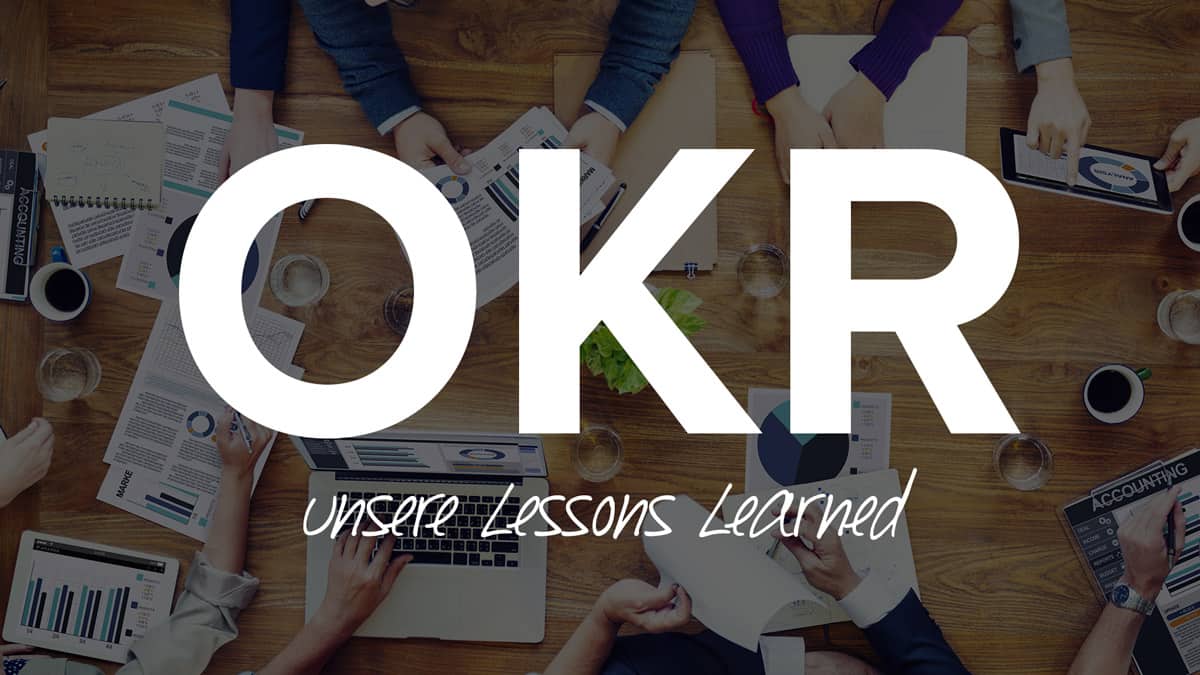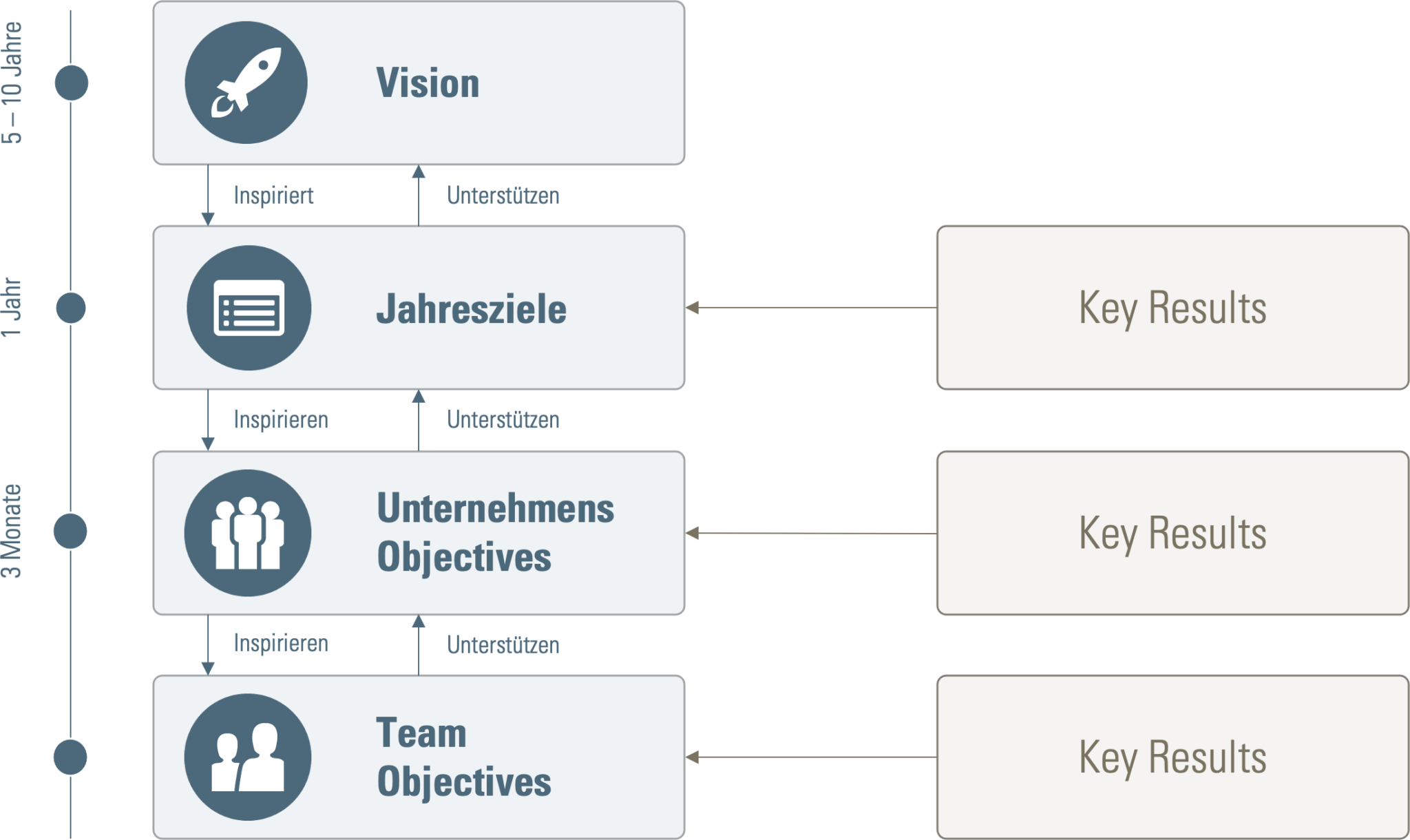
April 2021
OKR@it-economics 2018-2021: Our Top 12 Lessons Learned
Agile methods and procedures are now used in many industries and projects and have established themselves alongside "classic" project management. In order to be able to cope with the constant changes, many companies are also restructuring their internal organization towards lean, agile structures. The OKR framework was implemented at it-economics from October 2018 after a pilot project. Since then, more than two years have passed and we have had a lot of experience with OKRs. A good time for a little retrospective. Before that, however, we would like to briefly discuss the topic of the OKR framework.
OKR - What is it?
OKR is a management method or framework that focuses on qualitative goals to which quantitative results are assigned. The focus of the OKR framework is a three-month, iterative process during which goals (objectives) and associated key results (key results) are defined and the respective progress is tracked. Similar to the agile approach according to Scrum, the goal is to achieve an incremental improvement in each cycle.
The goals are formulated at all levels of the company, whereby they are derived along the corporate structure, starting from a common vision, via the management, the team leaders and the individual employees.

If the OKR framework is implemented and lived correctly, the following advantages result:
- Alignment: Alignment of all employees and their tasks with the overarching corporate goals
- Transparency: Everyone knows what the rest of the team is doing – avoiding resource conflicts and utilizing synergies
- Intrinsic motivation: Independent goal setting by all employees, resulting in a strong personal bond with the self-defined goals and thus the corporate goals
- Focus: Focusing on the 3-4 essential key results/objectives enables concentration on the essentials
- dynamics. Short, iterative cycles allow a quick reaction to market impulses or other influences without losing sight of the corporate vision
So much for OKR in brief; Time for a little journey back in time to 2018.
Flashback: California Dreamin' 2018
California - Heart of hippie culture, cradle of Star Wars and home to numerous world-class IT companies such as Apple, Google, Facebook, Intel and many more. So it is only fitting that in 2018 the management of it-economics came here in search of new impetus and the further development of the company. In addition to photos and souvenirs as well as one or two sunburns, the troupe brought further input with them: the OKR framework.
Hit parade: Our twelve lessons learned
Now the background is explained and we can start with our retro - we have learned the following twelve lessons.
1. For the best possible effect, OKRs must be practiced at all levels
Ideally, the majority of all employees in the company have internalized the OKR framework and its values - OKR becomes part of the company DNA. To achieve this, managers in particular must set a good example – at all levels.
2. An introduction top-down or governing through does not make sense
Changes and transformations always cause a certain amount of unrest in the company - all the more important is the participation of employees at all levels and the consideration of their objections and suggestions. A top-down implementation creates unrest and can lead to numerous team members opting out or passively resisting.
3. A “critical mass” of supporters and role models is required for successful implementation
The more people understand the OKR framework and its benefits, the easier and more comprehensive the adoption will be. A small group of enthusiasts and supporters is not enough to implement and live OKRs company-wide.
4. A comprehensive (knowledge) basis creates a common understanding
Reorganizing the company's organization and structure ties up resources and can also require significant financial resources. Nevertheless, it makes sense to teach the basics of the OKR framework to as many employees as possible, or at least to all team leaders and executives, in a workshop. This also helps to clarify mutual role expectations and to prevent misunderstandings.
5. Company Objectives: Market of ideas instead of cliques
Due to the strategic component of OKRs, it is completely understandable and also makes sense that the management has a say in finding the company objectives. However, it does not make sense for a small, exclusive group of people to set the goals without the participation of the employees. This causes frustration and the perception of OKRs as a "spaceship" or an elite clique.
It is much better if the company objectives emerge from a competition or market of ideas with the input of the teams and management. This ensures greater satisfaction and greater identification with the company's goals.
6. Missing Link: Company Objectives and Company Vision
According to the OKR framework, the Company Objectives (COs) and the associated Key Results should have a clearly visible reference to the company vision and contribute to it. If this link is not recognizable or not sufficiently communicated, the question of meaning quickly arises ("Why are we doing this at all?"). It is important that everyone involved in the planning knows and understands the company vision - this can serve as a kind of quality criterion for the OKRs.
7. Lack of Vision: The corporate vision is known and internalized
Ideally, a company vision acts as a kind of guiding star: Always present, intuitively understandable and (almost) unattainable. A lack of vision has a negative impact on the OKR system: it is difficult to set a course if the fixed point or fixed star is not clear or known. It is even better if everyone has the opportunity to participate in finding and formulating the corporate vision.
8. Ask for the WHY: The W-questions are (not) answered
This point is directly related "II. Introduction" together: If OKR is "put over" the existing structures without explanation, a large part of the momentum is lost from the outset: Why is OKR introduced? Why are we doing this? What do objectives and key results bring me in everyday life? Will this make me better or more efficient?
If these questions are not answered initially or if there is no opportunity to ask questions, a large part of the potential that OKR offers is lost.
9. Rule of numbers: OKRs are more than a controlling tool
It is tempting: With OKR and with the appropriate participation and the resulting transparency, completely new insights into the company are possible - and (apparently) new control options. However, OKRs are not intended as a controlling tool and key results in the style of "We generate € xx million sales in Q4" are not really inspiring. This can all be controlled via appropriate KPIs. OKRs have an indirect effect on sales figures etc., but do not focus on them.
10. Kaizen: OKRs are never perfect / not "evergreens"
In day-to-day business, there are "perennials" that reappear seasonally or at certain intervals or that come into focus. These are seemingly simple objectives that, at first glance, can't go wrong or can be reused. However, these "evergreens" are not "real" objectives: Objectives are completed after the respective cycle and cannot be recycled as often as desired. In addition, OKRs are never perfect, but continue to develop from cycle to cycle - regular quality control and comparison with the criteria is therefore necessary after each cycle.
11. Spaceships: OKRs are (not) integrated into everyday work
This lesson is directly related to lesson V: If the company objectives are set by an elite group, they often cannot be integrated into everyday life and are regarded as additional effort or ballast "from above". OKR is perceived as a spaceship that hovers completely detached above things and has nothing to do with everyday life and the observations and perspectives of the team members. The close involvement of the employees in the search for ideas and determination prevents this danger and the resulting frustration at an early stage.
12. Communication, communication, communication
One of the most elementary parts of the OKR framework is communication and transparency. Specifically, some time and resources must be invested to make the framework work - time that is missing for customer projects or other things.
Consistency and honesty are crucial here:
How important is the implementation and successful use of OKRs to us as a company? Are we ready to make this investment? Unclear communication channels and responsibilities result in unnecessary additional work and frustration - keyword "ballast". If no one knows what rounds there are and where what is decided, only one thing arises: Total confusion. A half-hearted implementation and sporadic communication is not effective and costs significantly more time and nerves in the long run than a thorough setup at the beginning. If you want to bring in a good harvest or achieve a good return, you first have to invest something - it's worth it.
OKR@it-economics: Outlook
Since the introduction of OKR@it-economics, we have experienced the twelve lessons listed with varying degrees of intensity and have learned a lot as a result. One or two painful realizations have led to extensive adjustments to the OKR system and we are always trying something new. We're staying tuned and evolving - every cycle.
teaspoon; dr
After a little over two years of working with the OKR framework, we were able to learn some elementary things - essentially the following: The theory and practical application of a framework are two completely different things; the participation of all team members is essential for success. The introduction using the top-down principle is no longer up-to-date and does not fit into agile companies in the VUCA environment.
You must view the contents of reCAPTCHA load to submit the form. Please note that data is exchanged with third-party providers.
More information


